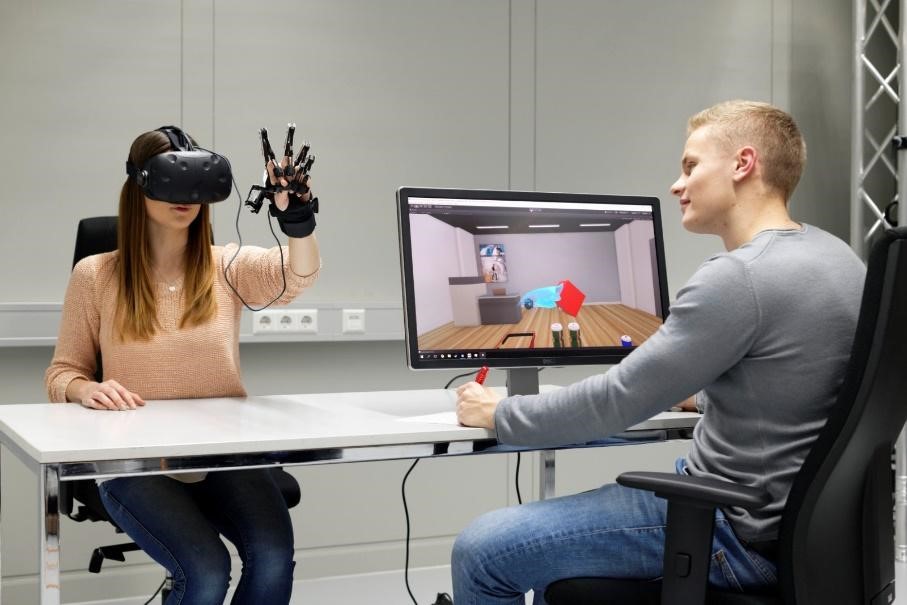Guideline for accessible images and tables
If you cannot follow these guidelines please inform the editors or send us an E-Mail to openpublishing@tib.eu.
Every image, and ideally every table, should be accompanied by appropriate alternative text. There are different methods possible for different figures. Therefore, in general it is advisable to inform yourself about standards for Alt Text generation. This decision tree offers an excellent resource to quickly gain an overview of the standards.
In most cases scientific papers explain an image more thorough in the text. Therefore it is good practice to reference this text passage in the Alt Text itself. Examples are: "Further description under 1.1.1" or "See caption".

Figure 1. Virtual reality interaction setup with a user wearing a VR headset and motion-tracking gloves while an observer monitors the virtual environment on a computer display.
Example Alt Text:
A woman wearing a virtual reality (VR) headset and motion-tracking gloves interacts with a virtual environment, while a man sitting across from her observes the simulation on a computer screen. The screen displays a 3D-rendered room with interactive objects. Further described under the section: "1.1.1".
If you have lots of images and find yourself having difficulties coming up with Alt Texts, we can recommend using a generative AI like ChatGPT or Mistral to generate them. A suitable prompt could be: "Create descriptive alt text for this image in one or two sentences." It can further improve the Alt Text generation if you give additional details about the image (eg. setting). For examples see the prompts below:
Example Prompts:
For images:
„Create concise and descriptive alt text (1–2 sentences) for this figure. Focus on the key visual elements that are relevant to the manuscript’s content. Do not start with ‘Image of’ or ‘Picture of’. Keep it under 150 characters if possible.
Figure Caption: [Insert your figure caption here]
Additional Context (optional): [Briefly describe what the figure represents, its setting, or what aspect is important for understanding it.]“
For tables:
„Write a short and clear alt text (1–2 sentences) summarizing the key information or structure presented in this table. Focus on what the table shows (e.g., comparisons, trends, key variables) without repeating the caption.
Table Caption: [Insert your table caption here]
Additional Context (optional): [Add a short explanation of the purpose or the main insight from the table if helpful.]“
Do's and Don'ts
✓ DO's
- Be concise and relevant - Focus on what's essential to understanding the argument (aim for a maximum of 100-150 characters)
- Describe key information in context - Include details directly relevant to your manuscript's specific purpose
- Use proper formatting - Ensure Unicode characters, correct spelling, and proper punctuation
- Integrate with surrounding text - The more you describe figures in your main text, the less detailed your Alt Text needs to be
- Handle complex visuals appropriately - For diagrams/charts, consider adding a long description as supplement material when necessary
- Submit data as text - Tables and text diagrams should be submitted as actual text, not images
- Use "See caption" or "See main text" - When the figure is already fully described elsewhere and alt text would be redundant
✗ DON'Ts
- Don't make figures your only source - Never use images as the sole way to convey critical information
- Don't duplicate existing text - Avoid repeating captions or sentences from the surrounding text
- Don't add interpretation - Include only what's visible, not additional analysis that sighted readers wouldn't see
- Don't include metadata - Leave out author names, dates, sources, or bibliographical references (these belong in captions)
- Don't start with "image of" or "picture of" - This is redundant since screen readers already identify it as an image
- Don't forget context matters - The same image may need different Alt Text in different publications
Sources and further information:
Eggert, E., Abou-Zahra, S., & Elton, B. (2024, May 13). Alt decision tree. W3C Web Accessibility Initiative (WAI) Tutorials. Retrieved from https://www.w3.org/WAI/tutorials/images/decision-tree/
Algieri, F. Bühring, and G. Cornefert, "Image Alt Text: How to Make Your Scientific Publication More Accessible," De Gruyter Conversations, Dec. 12, 2023. [Online]. Available: https://blog.degruyter.com/image-alt-text-how-to-make-your-scientific-publication-more-accessible/.